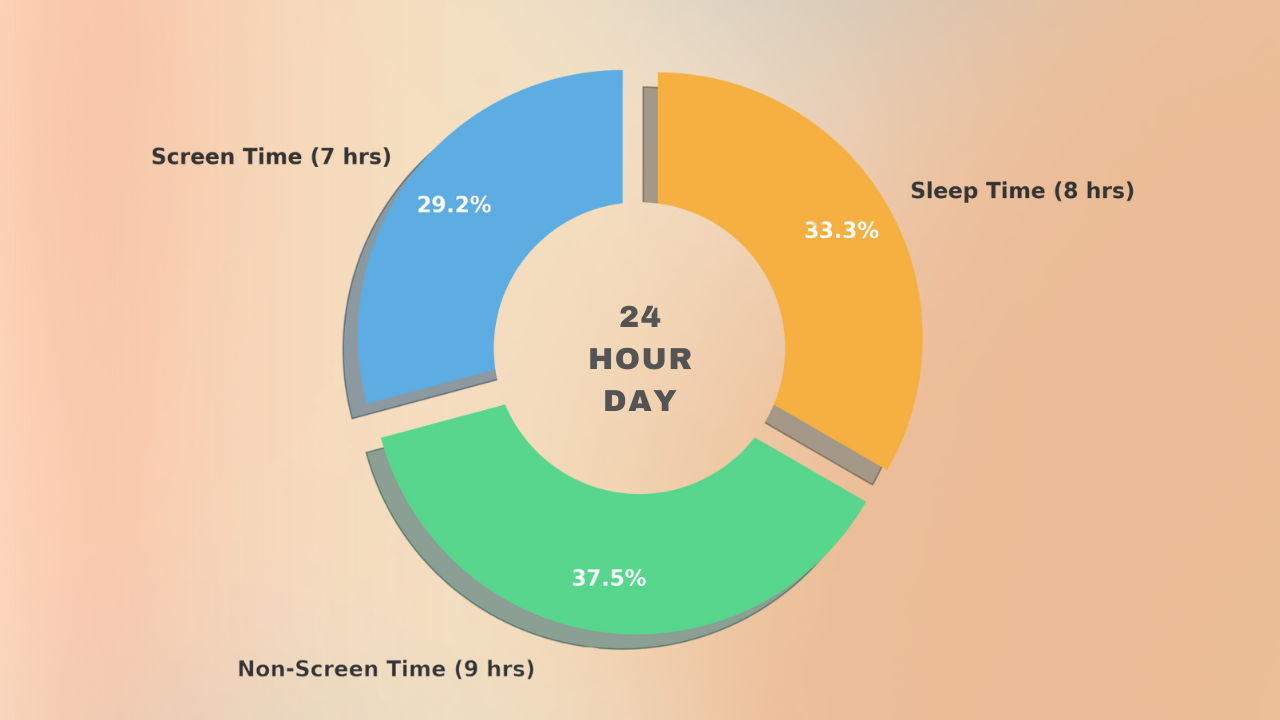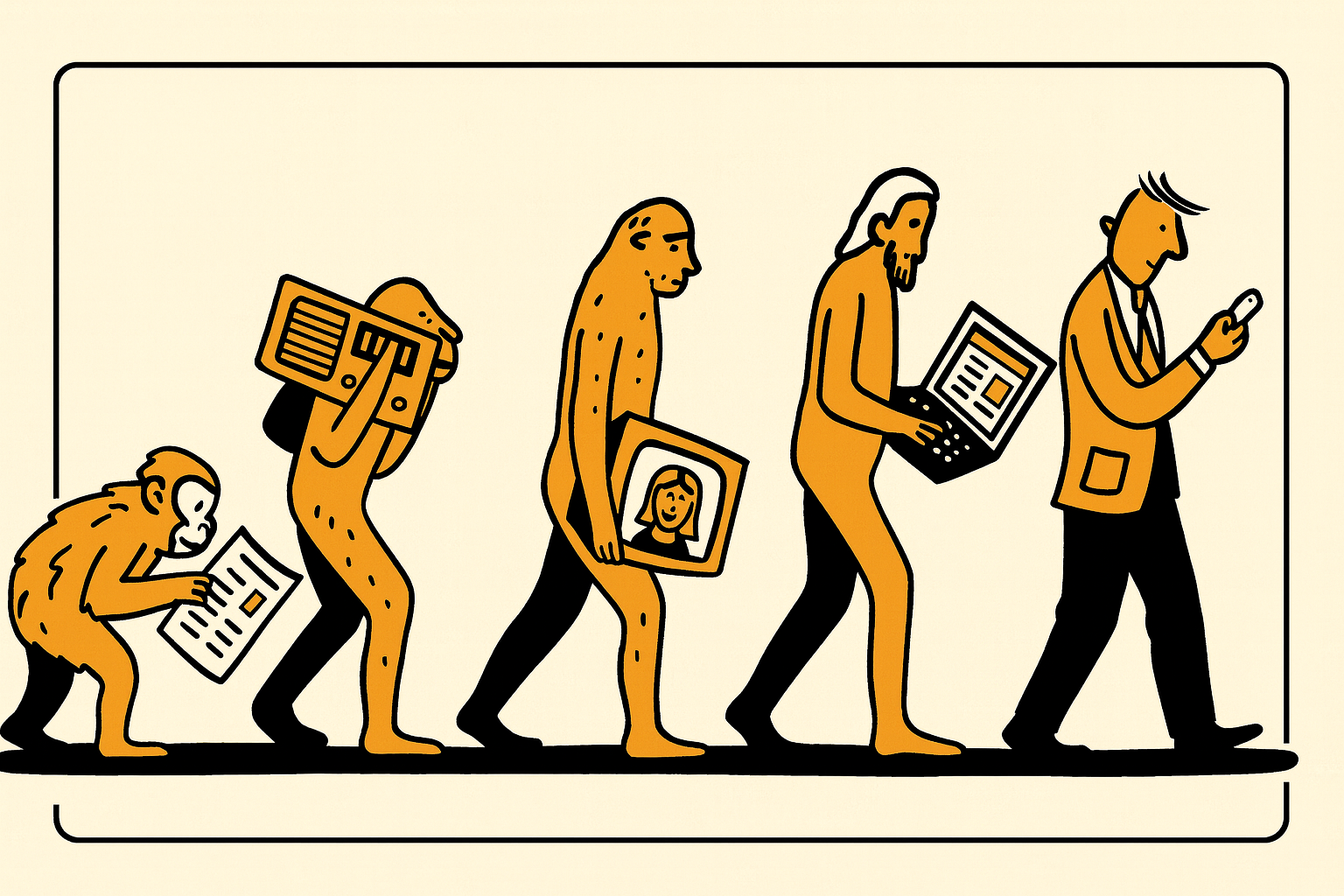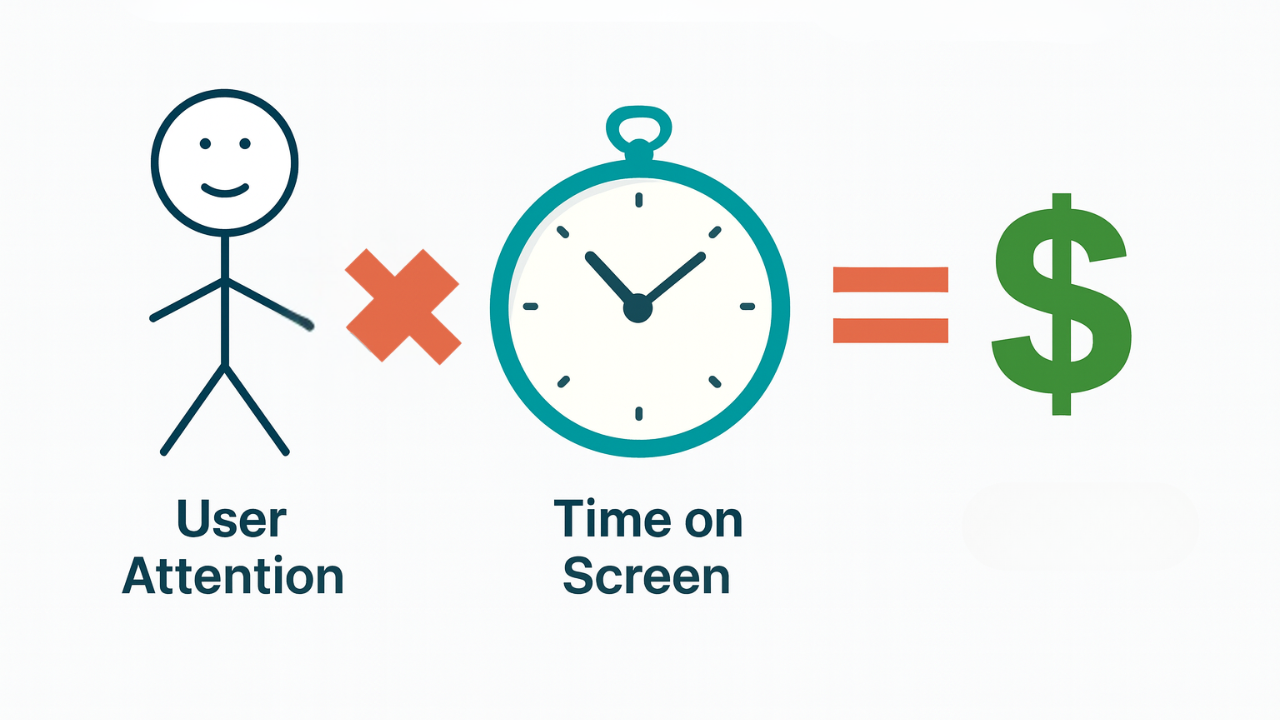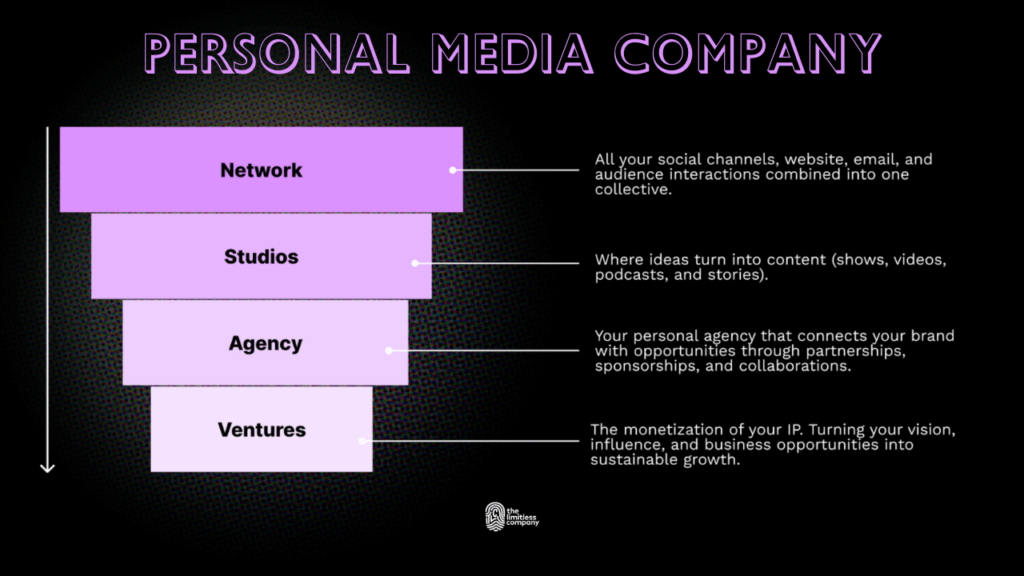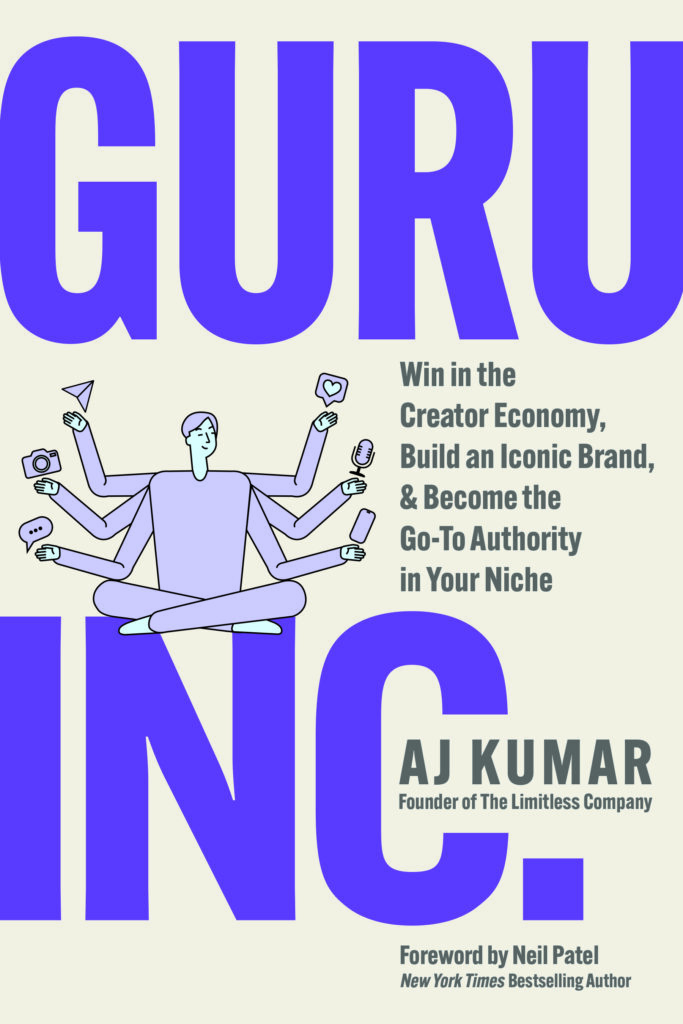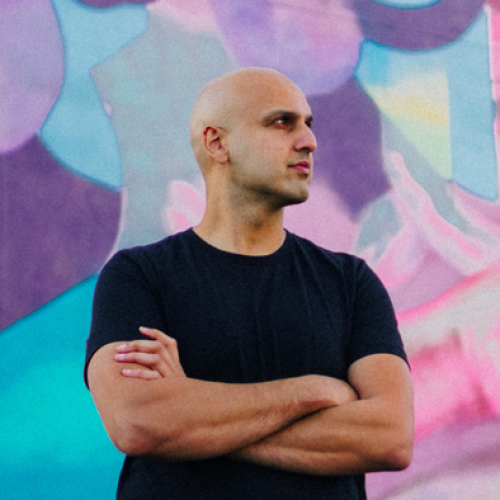The average person now spends 6 to 8 hours a day staring at screens, from phones to computers to TV. Over a lifetime, that adds up to more than 30 years spent looking at glass instead of the real world. Multiply that across the 5+ billion people connected to the internet, and you’re talking about 150+ billion years of collective human attention being poured into screens every single generation.
That’s not just mind-blowing trivia. It’s the foundation of the most valuable economy of our time: The Attention Economy. Attention isn’t just something we “spend” online. It’s the raw material driving trillions in revenue for platforms, advertisers, and creators. It has become the oil of the digital age: scarce, finite, and fought over by everyone from TikTok influencers to trillion-dollar tech giants.
And here’s the real shift: we’re no longer just using the internet. We’re living inside it. Our consciousness, our relationships, our work, and our entertainment are increasingly flowing through screens. Which means the game has changed. Success today isn’t about who has the best product or the biggest ad budget. It’s about who can capture, hold, and convert attention.
The ones who understand this and treat attention like the currency it is aren’t just building audiences. They are building media companies made up of interconnected ecosystems of content, channels, and intellectual property that transform attention into lasting equity.
This is the new gold rush. And the question isn’t whether you’ll take part in it. The question is: will you be a consumer of attention, or a merchant of it?
Key Takeaways
- Attention has become the world’s most valuable currency. With over 150 billion years of collective human attention flowing through screens every generation, those who can systematically capture and convert this attention are building the defining businesses of our era.
- The creator economy is just the beginning of a media company revolution. What started as individual creators posting content has evolved into sophisticated personal media empires with network distribution, content production, monetization, and the business of IP development.
- Traditional business models are being disrupted by attention merchants. Companies that understand how to capture voluntary attention through valuable content are outcompeting those relying on traditional advertising and marketing alone.
From Newspapers to Neural Networks: The Evolution of Attention Commerce
The attention economy didn’t start with TikTok. Its roots trace back over a century, but each era has fundamentally transformed how attention gets captured and monetized.
Newspapers pioneered the model in the 1800s with the penny press, papers sold cheap while profits came from selling reader attention to advertisers. Radio took it further in the 1920s with sponsored programming, literally embedding soap companies into soap operas. Television raised the stakes by capturing both eyes and ears, turning prime-time slots into the most valuable real estate in culture.
For decades, the formula stayed consistent: create content that captures attention, then sell access to that attention to advertisers. But the internet changed everything.
Instead of selling attention in bulk to mass audiences, platforms began tracking it in real-time, measuring every click, scroll, and second of engagement. Social media accelerated this shift by creating infinite content supply and personalized algorithms that turned attention capture into a 24/7 global competition.
Then came the pandemic, and human consciousness collapsed almost entirely onto screens. Work, school, relationships, entertainment — everything moved digital. We weren’t just spending time online anymore. We were living online.
Now AI is creating the next transformation. ChatGPT reached over 700 million users faster than any platform in history. Perplexity and Google’s AI Mode are revolutionizing how we discover information. Attention isn’t just being tracked, it’s being anticipated, personalized, and served up through conversational interfaces that know what we want before we ask.
The throughline is clear: attention has always been currency. But the scale, precision, and integration into daily life has reached a tipping point where attention merchants aren’t just media companies, they’re the most powerful businesses in the world.
How Attention Works as Currency
Understanding how today’s attention economy actually works reveals why some creators and companies dominate while others struggle with the same content.
YouTube operates on watch time. The platform doesn’t just host videos, it harvests minutes and hours of focused attention. Creators earn revenue based on how long they can hold viewer focus, creating direct correlation between attention captured and income generated. But YouTube also serves ads during that captured attention, creating a double monetization layer where both creator and platform profit from the same attention.
Instagram monetizes engagement minutes. Every scroll, like, comment, and story view represents quantified attention being converted into advertising opportunities. The platform’s algorithm optimizes for “time spent in app,” making engagement minutes the actual currency rather than follower counts or post likes.
TikTok maximizes session duration. The “For You” page is engineered to create infinite scroll sessions. The longer users stay engaged, the more data points the algorithm collects and the more advertising opportunities get created. TikTok doesn’t just show you content, it studies your attention patterns to predict what will keep you watching next.
The shift from traditional demographics to session-time optimization changes everything about how content succeeds. Platforms now prioritize content that generates sustained attention from diverse audiences over content that targets specific demographics. This is why “mass appeal” content often outperforms niche-targeted content in algorithmic distribution. The business model rewards creators who can capture broad attention, not just precise audience segments.
The Rise of Attention Merchants
Tim Wu coined the term “attention merchant” to describe entities that capture human attention and sell it to advertisers. Today’s attention merchants operate at two distinct levels, creating a new economy of influence and authority.
Platform merchants control the infrastructure where attention gets captured and traded. Google, Meta, TikTok, and YouTube provide the digital real estate and take a percentage of every attention transaction that happens on their platforms. They’ve become the oil companies of the digital age — they don’t create the raw material, but they control the refineries and distribution networks.
Creator merchants are individuals who build attention assets and monetize them directly. These are the YouTubers, TikTokers, newsletter writers, and podcasters who’ve mastered earning voluntary attention from specific audiences. Unlike traditional media personalities who needed networks and studios, creator merchants own their relationship with their audience and control their monetization strategies.
The democratization is striking. Emma Chamberlain started making YouTube videos as a 16-year-old in her bedroom. She understood intuitively that authenticity could capture attention more effectively than polished production values. By creating content that felt genuine and unscripted, she built an audience of millions who voluntarily allocated their attention to her consistently. This attention became the foundation for a media empire worth millions. We’re talking brand partnerships, her own coffee company, and influence extending far beyond YouTube.
Her success reveals the new economics of fame and business. Previously, capturing large audiences required massive capital investment in studios, distribution networks, and marketing campaigns. Now, a single person with a smartphone and internet connection can build audiences that rival traditional media outlets.
The Four-Layer Personal Media Company Model
Most creators stop at content creation, missing the opportunity to build sustainable media companies. The most successful attention merchants operate across four integrated layers that transform captured attention into lasting business value.
The Network Layer: Owning Your Distribution
Instead of depending on single platforms, successful attention merchants build interconnected networks across YouTube, TikTok, Instagram, LinkedIn, podcasts, newsletters, and emerging channels like AI search platforms. This creates a “network effect” where each channel reinforces and amplifies the others.
The goal isn’t just multi-platform presence — it’s creating your own distribution ecosystem where content flows seamlessly across channels, maximizing reach and lifetime value of every piece of content created. When someone discovers you on TikTok, they can find you on YouTube, subscribe to your newsletter, and follow your podcast. Each touchpoint deepens the relationship and increases the total attention you can capture from each audience member.
MrBeast exemplifies this approach. His YouTube channel drives traffic to his chocolate bars, which create content opportunities for his channel, which promotes his other products, which generates content for his social media, which drives more YouTube subscribers. Every layer feeds every other layer.
The Studio Layer: Systematic Content Production
The studio layer treats content creation as a professional media operation rather than random posting. This involves developing recurring formats and series, maintaining consistent production workflows, and creating content that naturally integrates products and services.
Think like Netflix: content is your product, attention is your metric, and monetization opportunities are built into every piece of content from conception. You’re not just making videos or posts, you’re producing shows and series that audiences want to follow consistently over time.
Gary Vaynerchuk has turned this into an art form. His daily content, podcast appearances, and speaking engagements don’t just build personal recognition, they demonstrate his agency’s marketing expertise in real-time. Prospects see his reach and engagement as proof of concept for what his agency can deliver for clients.
The key is integration over interruption. Instead of stopping content to sell something, successful studio operations make their offerings part of the entertainment and educational value.
The Agency Layer: Converting Attention Into Revenue
Once attention is captured through network and studio operations, the agency layer converts it into revenue through multiple channels. This includes strategic brand partnerships, direct-response offers for products and services, audience-driven demand generation, and affiliate marketing systems.
This is where attention transforms from vanity metrics into business outcomes. When customers trust you personally through your content, that trust transfers to your company, creating what psychologists call the “halo effect.” Sales cycles shorten when prospects recognize leadership personally. Close rates improve when customers feel connected to the people behind the business.
The agency layer operates on what I call Return on Attention Created (ROAC), a principle I co-created with my business advisor, Roy Cammarano. Unlike traditional ROI, which focuses only on immediate financial returns, ROAC measures the broader value of attention:
- Identity value: Personal brand equity that opens doors and creates opportunities.
- Trust value: Credibility that converts to influence and recommendation power.
- Leverage value: The ability to turn attention into monetization, partnerships, and long-term compounding growth.
Smart attention merchants track ROAC across extended time horizons, recognizing that attention invested today may generate returns months or years later through relationship building and authority establishment.
The Venture Layer: Building Long-Term IP Assets
The venture layer is the strategic core of the entire ecosystem. It houses your intellectual property, brand assets, content libraries, and product lines, but more importantly, it directs how those assets shape decisions across the other layers.
This layer ensures that every partnership, piece of content, and distribution channel contributes to a larger, long-term vision. It’s where attention captured by the network, amplified by studios, and activated by the agency gets transformed into enduring equity.
Venture assets include proprietary content formats, integrated product lines, customer databases, licensing deals, and businesses spun off from your personal brand. These are the elements that survive platform shifts, algorithm updates, and cultural trends.
Codie Sanchez embodies this perfectly. Her content about buying small businesses doesn’t just build an audience; it funnels into her newsletter, fills her courses, drives deal flow for her investment fund, and generates consulting opportunities. Her venture layer turns attention into a multi-dimensional business ecosystem.
The Psychology Behind Attention Capture
Understanding why some content commands attention while similar content gets ignored requires looking at how human psychology intersects with digital platforms.
Our brains have evolved sophisticated attention filtering systems. The anterior cingulate cortex constantly evaluates whether something deserves our focus based on relevance, novelty, and potential reward. Content that triggers this evaluation positively gets our attention. Content that doesn’t gets filtered out automatically.
This is why authenticity works so powerfully in the attention economy. When Emma Chamberlain shares genuine reactions or behind-the-scenes moments, viewers’ mirror neurons activate, creating empathy and connection that polished corporate content cannot replicate. People don’t just watch authentic content, they feel it.
Consistency builds what neuroscientists call “predictive coding.” When audiences know that consuming your content will reliably deliver value, their brains create positive associations that make them more likely to allocate attention to you in the future. This is why successful creators maintain regular publishing schedules and consistent quality standards.
Storytelling remains the most powerful attention capture mechanism because stories create what researchers call “transportation,” the psychological phenomenon of becoming absorbed in a narrative. When someone is transported by your story, they’re not just passively consuming content. They’re mentally simulating the experiences you’re describing, creating deeper engagement and stronger memory formation.
The Future of the Attention Economy in the Age of AI
As AI reshapes how people discover and consume information, the attention economy is entering its next phase. Instead of scrolling through feeds, users increasingly ask AI systems for direct answers and recommendations. This shift creates new opportunities and challenges for attention merchants.
AI systems like ChatGPT and Perplexity don’t just provide information, they make judgment calls about which sources to trust and reference. This means establishing authority and expertise becomes even more crucial. Surface-level content creators will be commoditized by AI, while deep, authoritative voices become more valuable as trusted sources AI systems cite and recommend.
The most successful attention merchants will focus on becoming the definitive authorities in specific domains. Instead of trying to capture attention through viral content or trending topics, they’ll build systematic expertise and consistent value delivery that makes them the obvious choice when AI systems need trusted sources.
This represents a return to fundamentals: attention merchants who provide genuine value, build real expertise, and maintain authentic relationships with their audiences will thrive. Those who’ve built their success on platform tricks or algorithmic manipulation will struggle as AI systems prioritize quality and trustworthiness over engagement metrics.
Building Your Attention-Based Media Company
The opportunity to build a personal media company has never been more accessible, but it requires thinking systematically about how to capture, organize, and monetize attention over time.
Start by designing your network architecture. Select platform combinations that reinforce each other rather than competing for your time and attention. Build email lists and direct communication channels that give you owned media alongside your rented platform presence. Consider how emerging channels like AI search will fit into your overall distribution strategy.
Develop studio operations that treat content creation like professional media production. Create recurring formats and show concepts that audiences can follow over time. Build content calendars and production workflows that maintain quality while enabling consistent output. Most importantly, integrate opportunities to showcase your expertise and offerings into the content itself.
Implement agency functions that convert attention into multiple revenue streams. This might include consulting, speaking, courses, products, affiliate partnerships, or direct service offerings. The key is creating offers that serve your audience’s needs while leveraging the trust and authority you’ve built through consistent value delivery.
Finally, focus on venture assets that create long-term value independent of any single platform. Develop proprietary intellectual property, build customer databases and direct relationships, create products and services that complement your content, and establish brand value that transcends individual pieces of content.
This layered approach, network, studio, agency, and venture, is the foundation of what I explore in my new book Guru Inc. It’s a book about how the attention economy gave birth to the creator economy, and how the real opportunity lies not in chasing trends but in mastering positioning, perception, and systematic growth. What you’re building isn’t just content, it’s context, identity, and equity in your own personal brand. That’s the essence of turning a creator into a company.
Those 150 billion years of collective human attention represent the largest economic opportunity in human history. Every hour of screen time represents currency waiting to be earned by those skilled enough to deserve it. The question isn’t whether the attention economy will continue growing. The question is whether you’ll build the systems to capture your share of humanity’s most precious resource: conscious attention in an increasingly digital world.



